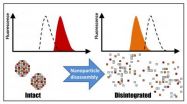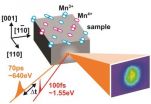(Press-News.org) The use of transplant organs from animals (xenotransplantation) could help to compensate for the shortage of human organs available for transplant. NIH researchers have demonstrated that by using hearts from genetically engineered pigs in combination with target-specific immunosuppression of recipient baboons, organ survival can be significantly prolonged. This has potential for paving the way for the use of animal organs for transplantation into humans.
Toronto, ON, Canada, April 28, 2014 – Cardiac transplantation is the treatment of choice for end stage heart failure. According to the National Heart, Lung, and Blood Institute (NHLBI) of the National Institutes of Health, approximately 3,000 people in the US are on the waiting list for a heart transplant, while only 2,000 donor hearts become available each year. Therefore for the cardiac patients currently waiting for organs, mechanical assist devices are the only options available. These devices, however, are not perfect and have issues with power supplies, infection, and both clotting and hemolysis.
Transplantation using an animal organ, or xenotransplantation, has been proposed as a valid option to save valuable human lives. Muhammad M. Mohiuddin, MD, of the Cardiothoracic Surgery Research Program at the NHLBI, and co-investigators have now developed techniques to overcome some of the immunologic roadblocks that hinder successful xenotransplantation using genetically engineered pigs as a source of donor organs. Pigs were chosen because their anatomy is compatible with that of humans and they have a rapid breeding cycle, among other reasons.
As the result of recent improvements in technology for genetic modification of pigs, genes that are immunogenic for humans have been eliminated ('knocked out") and several human genes have been added to the pig genome. Grafts from these genetically engineered (GE) pigs are less likely to be seen as foreign, thus reducing the immune reaction against them. These modifications should also allow transplants utilizing lower amounts of toxic immunosuppressive drugs.
"These recent scientific developments in the field of genetic engineering, along with the generation of novel target specific immune suppression, and their favorable impact on organ and cellular transplantation, may instill a new ray of hope for thousands of patients waiting for human donor organs," comments Dr. Mohiuddin.
The NHLBI group was fortunate to have access to GE pigs through close collaboration with Revivicor, Inc. Experiments using these GE pig hearts, transplanted in the abdomen of baboons along with their native hearts, were designed to study the usefulness of these GE pigs along with several new target-specific immunosuppressive agents in prolonging the graft survival. Through the combination of a pig heart with certain gene modifications, with drugs suppressing both T and B cell immune responses, investigators were able to prolong the graft survival in baboons to over one year. This unique achievement by the NIH laboratory is twice as long as previously reported.
The long-term surviving grafts exhibit normal histology (cellular architecture) and contractility. The researchers' next step is to use hearts from the same GE pigs with the same immunosuppression utilized in the current experiments to test their ability to provide full life support by replacing the original baboon heart.
"Based on the data from long-term surviving grafts, we are hopeful that we will be able to repeat our results in the life-supporting model. If successful, this method could change the current transplant paradigm, eliminating the shortage of donor organs including hearts, livers, kidneys, intestine, as well as insulin producing cells for treatment of diabetes," concludes Dr. Mohiuddin. He is presenting the results of this research at the 94th AATS Annual Meeting in Toronto, ON, Canada on April 28, 2014.
INFORMATION: END
Technological advancements extend survival of transplanted hearts across species
Presentation at 94th AATS Annual Meeting describes combination of donor genetic modifications and host-targeted immunosuppression
2014-04-28
ELSE PRESS RELEASES FROM THIS DATE:
Disney Researchers use 3-D printing to produce interactive speakers of any shape
2014-04-28
Forget everything you know about what a loudspeaker should look like. Scientists at Disney Research, Pittsburgh have developed methods using a 3D printer to produce electrostatic loudspeakers that can take the shape of anything, from a rubber ducky to an abstract spiral.
The simple speakers require little assembly, but even those few manual steps might be eliminated in the future, said Yoshio Ishiguro, a Disney Research, Pittsburgh post-doctoral associate. "In five to 10 years, a 3D printer capable of using conductive materials could create the entire piece," he predicted.
The ...
Well-informed patients key to accepting gene-based drug dosing
2014-04-28
A new study out of Western University (London, Canada) illustrates the need for a lot more education around pharmacogenetics (PGx) –the study of how a patient's genes can affect drug reaction and dosage. PGx promises to optimize patient response to therapy, but this is the first study to really investigate how patients perceive this kind of genetic testing, and whether those perceptions differ when it comes to parents and their children. The research, led by Dr. Michael Rieder of Western's Schulich School of Medicine & Dentistry is published in the journal Pediatrics.
"Pharmacogenetic ...
The thin-crusted US Sierra Nevada Mountains: Where did the Earth go?
2014-04-28
Boulder, Colo., USA – In an addition to Geosphere's ongoing themed issue series, "Geodynamics and Consequences of Lithospheric Removal in the Sierra Nevada, California," Craig H. Jones of the University of Colorado Boulder and colleagues examine the seismological study of the entire extent of the U.S. Sierra Nevada range using seismograms collected in the Sierra Nevada EarthScope field experiment from 2005 to 2007.
The southern Sierra Nevada is known to have unusually thin crust for mountains with such high elevations (peaks higher than 4 km/14,000 ft, and average elevations ...
Precise brain mapping can improve response to deep brain stimulation in depression
2014-04-28
Experimental studies have shown that deep brain stimulation (DBS) within the subcallosal cingulate (SCC) white matter of the brain is an effective treatment for many patients with treatment-resistant depression. Response rates are between 41 percent and 64 percent across published studies to date.
One of the proposed mechanisms of action is the modulation of a network of brain regions connected to the SCC. Identifying the critical connections within this network for successful antidepressant response is an important next step.
A new study using MRI analysis of the ...
Wildfire outbreak in far eastern Russia
2014-04-28
According to the Voice of Russia, "As of Saturday morning, in Russia continue 103 wildfires at 27,412 hectares, including big 26 wildfires in the Far East and in Siberia. On Friday, 147 new fires began at 12,509 hectares, and 150 were extinguished at 5,437 hectares. Emergency situation has been introduced in the regions with most complicated situations - in the Amur region, in the Maritime and Baikal territories. This was according to the EMERCOM's (Emergency Control Ministry) spokesperson Alexander Drobyshevsky.
Satellites (such as Aqua and Terra) have located "1,587 ...
Cyberspace scholarship nets higher grades, better thinking for class Facebook group
2014-04-28
University students who used a Facebook group as part of a large sociology class did better on course assignments and felt a stronger sense of belonging, according to a Baylor University study.
The study has implications for the challenge of teaching large classes, a growing concern for higher education. Classes numbering hundreds of students — particularly in introductory courses — have become common at many universities, said researchers Kevin Dougherty, Ph.D., associate professor of sociology in Baylor's College of Arts and Sciences, and Brita Andercheck, a doctoral ...
Newborn Tropical Storm Tapah threatens Saipan and Tinian
2014-04-28
A tropical storm warning is in force for Saipan and Tinian as Tropical Storm Tapah moves north through the Northwestern Pacific Ocean on April 28. When NASA-NOAA's Suomi NPP satellite passed overhead and, imagery revealed a developing eye in Tapah.
In addition to the tropical storm warning, a typhoon watch is in effect for Alamagan and Pagan as Tapah is expected to continue in a generally northerly direction over the next couple of days. A typhoon watch means typhoon force winds of 74 mph or greater are possible within 48 hours. A tropical storm warning means tropical ...
Fluorescent-based tool reveals how medical nanoparticles biodegrade in real time
2014-04-28
Nanoparticles have been heralded as a potential "disruptive technology" in biomedicine, a versatile platform that could supplant conventional technologies, both as drug delivery vehicles and diagnostic tools.
First, however, researchers must demonstrate the properly timed disintegration of these extremely small structures, a process essential for their performance and their ability to be safely cleared out of a patient's body after their job is done. A new study presents a unique method to directly measure nanoparticle degradation in real time within biological environments.
"Nanoparticles ...
A glassy look for manganites
2014-04-28
Manganites – compounds of manganese oxides - show great promise as "go-to" materials for future electronic devices because of their ability to instantly switch from an electrical insulator to a conductor under a wide variety of external stimuli, including magnetic fields, photo-excitations and vibrational excitations. This ultrafast switching arises from the many different ways in which the electrons and electron-spins in a manganite may organize or re-organize in response to such external stimuli. Understanding the physics behind these responses is crucial for the future ...
Ozone levels drop 20 percent with switch from ethanol to gasoline
2014-04-28
A Northwestern University study by an economist and a chemist reports that when fuel prices drove residents of São Paulo, Brazil, to mostly switch from ethanol to gasoline in their flexible-fuel vehicles, local ozone levels dropped 20 percent. At the same time, nitric oxide and carbon monoxide concentrations tended to go up.
The four-year study is the first real-world trial looking at the effects of human behavior at the pump on urban air pollution. This empirical analysis of atmospheric pollutants, traffic congestion, consumer choice of fuel and meteorological conditions ...
LAST 30 PRESS RELEASES:
Numbers in our sights affect how we perceive space
SIMJ announces global collaborative book project in commemoration of its 75th anniversary
Air pollution exposure and birth weight
Obstructive sleep apnea risk and mental health conditions among older adults
How talking slows eye movements behind the wheel
The Ceramic Society of Japan’s Oxoate Ceramics Research Association launches new international book project
Heart-brain connection: international study reveals the role of the vagus nerve in keeping the heart young
Researchers identify Rb1 as a predictive biomarker for a new therapeutic strategy in some breast cancers
Survey reveals ethical gaps slowing AI adoption in pediatric surgery
Stimulant ADHD medications work differently than thought
AI overestimates how smart people are, according to HSE economists
HSE researchers create genome-wide map of quadruplexes
Scientists boost cell "powerhouses" to burn more calories
Automatic label checking: The missing step in making reliable medical AI
Low daily alcohol intake linked to 50% heightened mouth cancer risk in India
American Meteorological Society announces Rick Spinrad as 2026 President-Elect
Biomass-based carbon capture spotlighted in newly released global climate webinar recording
Illuminating invisible nano pollutants: advanced bioimaging tracks the full journey of emerging nanoscale contaminants in living systems
How does age affect recovery from spinal cord injury?
Novel AI tool offers prognosis for patients with head and neck cancer
Fathers’ microplastic exposure tied to their children’s metabolic problems
Research validates laboratory model for studying high-grade serous ovarian cancer
SIR 2026 delivers transformative breakthroughs in minimally invasive medicine to improve patient care
Stem Cell Reports most downloaded papers of 2025 highlight the breadth and impact of stem cell research
Oxford-led study estimates NHS spends around 3% of its primary and secondary care budget on the health impacts of heat and cold in England
A researcher’s long quest leads to a smart composite breakthrough
Urban wild bees act as “microbial sensors” of city health.
New study finds where you live affects recovery after a hip fracture
Forecasting the impact of fully automated vehicle adoption on US road traffic injuries
Alcohol-related hospitalizations from 2016 to 2022
[Press-News.org] Technological advancements extend survival of transplanted hearts across speciesPresentation at 94th AATS Annual Meeting describes combination of donor genetic modifications and host-targeted immunosuppression





